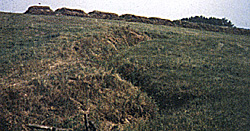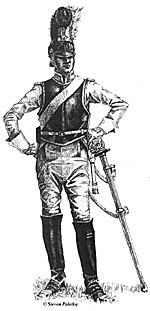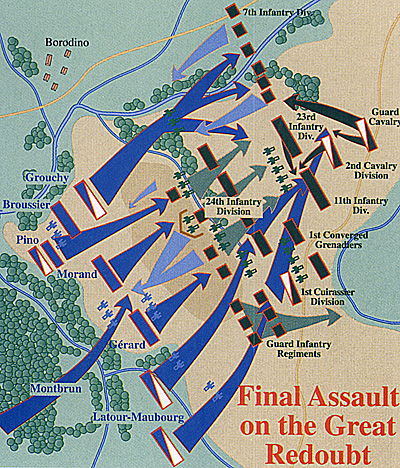 The struggle for the Great Redoubt - or Raevsky Redoubt - is the best known episode of the battle. Situated at the center of the Russian position, the massive entrenchment was
the most prominent feature on the field.
The struggle for the Great Redoubt - or Raevsky Redoubt - is the best known episode of the battle. Situated at the center of the Russian position, the massive entrenchment was
the most prominent feature on the field.
The Raevsky or "Great" Redoubt. Photo taken from the front, on the ground where the French 30th Infantry made their attack in mixed order. Note also the World War II trenches in the foreground.
Initial Assaults are Repulsed
Eugene, with Borodino secured on his left, prepared to seize his primary objective: Raevsky Redoubt. In a fashion his step-father would approve, Eugene massed his 4th Corps artillery and delivered a devastating preliminary bombardment that hammered the forces near and inside redoubt, including the needlessly exposed Russian 3rd Cavalry Corps.
At around 10:00 a.m., Broussier's division of Eugene's corps disappeared into the thick smoke as they made their way across the difficult ground - several men fell into some wolf pits the Russians had placed in front of the position to disrupt cavalry This attack was easily repulsed, Broussier's ranks shredded by canister fire from the 18 heavy artillery pieces in the redoubt.
Morand's Division, originally part of Davout's 1st Corps, made the second major attack, choosing to utilize a interlinked brigade formation of columns and lines known as l'ordre mixte, a difficult formation to keep well aligned. Advancing through the dense, suffocating smoke created by dozens of cannon and thousands of muskets firing, the five battalions of the 30th Line Regiment also encountered devastating canister fire as they approached the Russian position, and became extremely disordered.
The brigade commander, General Bonnamy, who would receive fifteen wounds on this day, coolly dressed the ranks of the 30th in a dip in the ground where the Russian artillery could not hit his men, and then ordered the regiment into a bayonet charge. The 30th poured through the gun embrasures of the redoubt and engaged the Russian gunners - who had orders to stand to their guns - in a bloody hand-to-hand combat. The Russian artillerists fought desperately, using their swords, handspikes and rammers, but were eventually overwhelmed. General Raevsky barely managed to escape the slaughter in the redoubt that bore his name, and, badly injured, he took little further part in the battle.
Unfortunately for the 30th, the remainder of Morand's division was too heavily engaged around the redoubt to follow up this initial success. The 30th tried to regroup and consolidate its hold on the key objective, but its numbers were rapidly diminishing.
The inevitable Russian counter- attack came, led by General Yermolov, who had been dispatched by Kutuzov to deal with the crisis. A former horse artillery battery commander himself, Yermolov took three horse artillery batteries from the Russian's large Artillery Reserve and had them gallop forward to unlimber and support his attack. This artillery fire raked the 30th Line through the opening at the back of the redoubt. Then Yermolov rallied some infantry battalions nearby, including two jaeger battalions, and led them forward in a bayonet charge that scattered the reirmants of the French defenders. Yermolov was then wounded and retired from the field. The valiant General Bonnamy, covered with lacerations and wounds, was captured in the redoubt and taken to Kutuzov. Bonnamy had pretended to be Marshal Murat in order to avoid being bayoneted, and Kutuzov was evidently disappointed to be presented with a mere Brigadier instead of a King.
One of the worst losses the Russians suffered was their young reserve artillery commander, General Kutaisov, who abandoned his primary duty in response to the initial loss of the redoubt and was killed leading an infantry charge to re-take it.
His absence severely disrupted the flow of fresh reserve artillery batteries into the battle, and robbed the Russians of apparently their only officer who seemingly understood the power of aggressively handled massed batteries. Kutaisov rejected the more conservative artillery doctrines of the past, which seldom permitted the artillerists to stand to the guns in close support of the infantry. Because of Kutaisov's influence, Borodino was the finest hour of the Russian artillery, where the artillerists not only stood to their guns, but heroically defended their pieces in savage hand-to-hand fighting.
Uvarov's Diversion Delays Renewed French Attacks
At about noon, with his initial attacks repulsed and rallying, Eugene was distracted by a large Russian cavalry raid which later became known as Uvarov's diversion. Authorized by Kutuzov himself sometime around 8:30 a.m., the great raid was intended to be a bold Russian counter-stroke which would surprise and possibly crush the French left flank. Uvarov's cavalry corps of 2,500 men and Platov's 2,000 cossacks, took part in the attack. Although Kutuzov and others had great hopes for the assault, it succeeded largely in overrunning some baggage wagons and spread panic among many non-combatants and wounded.
Clausewitz, a participant in Uvarov's diversion, was highly critical of the attack. Eugene Labaume, who served on Viceroy Eugene's staff, wrote one of the first published accounts of the battle, and he described the response to the flank attack:
"The Viceroy's attention had been entirely taken up by his centre, when it was recalled to his left by a grand movement of cavalry directed by the enemy on that point. General Delzons, who, since the morning, had been menaced by this cavalry, formed his first brigade into square on the left of the Borodino. Several times he was on the verge of being attacked, but the enemy, seeing that he could make no impression on him, advanced to the extremity of our left, and commenced a brisk attack on the Bavarian light cavalry, which were for a moment thrown into disorder.
The prince, who happened then to be at this point, threw himself into the middle of a square formed by the eightyfourth, and prepared to set it in motion, when the cossacks were , in their turn repulsed and, taking to flight, disengaged our left. Every thing was then restored to the greatest order.
 Trooper of the vaunted Zastrow Cuirassiers. Some sources claim that the Saxons left their armor cuirasses behind in 1812, making their battlefield exploits even more impressive.
Trooper of the vaunted Zastrow Cuirassiers. Some sources claim that the Saxons left their armor cuirasses behind in 1812, making their battlefield exploits even more impressive.
"The prince was found at all points exhorting every officer to do his duty and reminding him that on this day depended the glory of France."
Christopher Duffy summed up the attack's achievement: "For more than two hours, from mid-day until after two in the afternoon, the diversion had effectively paralyzed the French left and center."
Ironically, Uvarov was greeted with displeasure when he reported back to headquarters. "May God forgive you," Kutuzov told him, implying that he considered the attack had been a complete failure. Only years later did the Russians realize that the two hours this attack bought them and the impact it had in contributing to Napoleon's uncharacteristic sense of caution in withholding so many reserves - may have saved their army from catastrophic defeat.
Second Series of Assaults Capture the Great Redoubt
The eviction of the 30th Line from the Great Redoubt, followed by the appearance of Uvarov and Platov's diversion, had effectively suspended Eugene's attack at about noon. Meanwhile, as the French right continued to push the Russians back to the Semonskoya position (tour stop 5), and as Eugene withdrew some infantry in response to the Russian cavalry flank attack, a gap in the French lines opened up. This was filled by the 2nd and 4th Reserve Cavalry Corps which held the Russians back by their presence. This deployment, however, subjected some of the finest cavalry in the world to a savage artillery bombardment, during which the highly regarded French cavalry commander Montbrun was mortally wounded.
Napoleon's Imperial aide Auguste Caulaincourt, a man described by Labaume as "well-informed, sprightly, noble and generous," took over Montbrun's 2nd Reserve Cavalry Corps. Auguste Caulaincourt was in charge of Napoleon's headquarters during the 1812 campaign. His brother Armand was also at Imperial headquarters as one of Napoleon's aides. When Auguste received the Emperor's order to take command of Montbrun's corps, he embraced his brother and foretold that he would not be coming back alive.
A little after 2:00 p.m., under orders from Napoleon, Eugene renewed his attacks. An eyewitness described the scene:
"His Highness, riding along the line, arranged the attack with the utmost coolness, and led it himself at the head of Broussier's division. At the same instant a division of cuirassiers, from the centre of our army, rushed on the redoubt and offered to our astonished sight a grand and sublime spectacle. The whole eminence, which overhung us, appeared in an instant a mass of moving iron: the glitter of the arms, and the rays of the sun, reflected from the helmets and cuirasses,... mingled with the flames of the cannon, that on every side vomited death, gave to the redoubt the appearance of a volcano in the midst of an army."
In an unprecedented feat of arms, it was the cavalry which first entered the redoubt, ultimately spearheaded by the superb Saxon Cavalry, notably the Zastrow Cuirassiers and Saxon Garde du Corps. These two regiments had already fought hard that morning, helping to shatter the Russian defense around Semenovskaya. Now they charged forward again, seizing a fortified position from infantry!
Arriving just ahead of the decisive Saxon charge, Auguste Caulaincourt, now in command of Montbrun's corps, gallantly met his fate at the head of the French 5th Cuirassiers Regiment. Working their way around the left side of the redoubt while the Saxons would come in from the right, the 5th Cuirassiers were repulsed by a blast of musketry from supporting Russian infantry of the 24th Division. Napoleon, whether by mistake or design, gave the deceased Caulaincourt and his French cuirassiers credit for taking the redoubt (and, in fact, they probably were the first to enter but did not remain very long), a point which became one of Borodino's first great historical controversies.
Following swiftly on the heels of the cavalry, Eugene's infantry moved in to secure the remains of the redoubt and to finish off the Russian defenders. Eyewitness Heidrich von Brandt [from Paul Austin's 1812: The March on Moscow] describes the interior of the redoubt at this point: "Men and horses, alive, mutilated, dead, but lying by sixes and eights heaped on top of each other covered the approaches all around, filled the ditch and the work's interior. While we were advancing they were carrying away General Caulaincourt. He passed in front of us, carried by several cuirassiers on a white cuirassier mantle covered with great bloodstains."
Although notably few prisoners were taken during this savage fight, Russian General Lichatcheff, commander of the 24th Division, was spared and hurried off to be presented to Napoleon.
Meanwhile, Barclay had witnessed the French preparations for the assault. He countered it by ordering the entire 1st Cuirassier Division forward. Unfortunately for Barclay, someone had ordered the bulk of the division to deal with the crisis on the Russian left. An angry Barclay could only send forward the Emperor and Empress Cuirassiers, two of the finest regiments in the Russian cavalry. Later remnants of the Russian 2nd and 4th Cavalry Divisions would follow up this attack.
Eugene too had sensed an opportunity when the redoubt fell, and threw in the remainder of the French cavalry reserves against the Russian formations of the 7th Division and of Tolstoy's 4th Corps which had suffered terribly from the enfilading fire of the French Guard artillery Tolstoy himself was wounded early in the fighting.
Christopher Duffy described the ensuing cavalry encounter as the Russian cuirassiers came up:
- "During this two-hour battle on the plateau the Russian and French
cavalry regiments became almost inextricably mixed up with each other and
with the remnants of the Russian infantry, and in some places the dust was
kicked up in such dense clouds that no one could see more than ten yards
.... The Russian infantry commanders did what they could to rally their men
amidst the confusion. General Paskevich charged up and down, tearing out
his hair and swearing. Just as characteristically Barclay retained his
composure through the whole chapter of alarming episodes: at one time his
horse was shot out beneath him and he had to seek refuge in a square of
infantry: at another his loyal groom raised a pistol and shot a French
cuirassier from the saddle just as the man was about to split his master's
skull."
Labaume, who was with Eugene, wrote: "These were the best of their cavalry. The shock between their cuirassiers and ours was therefore terrible, and one may judge of the fury with which both parties fought, when the enemy, in quitting the field, left it completely covered with dead."
The French won the cavalry engagement, but were exhausted by their exertions. The Russians, beaten but not broken, drew back to reorganize. The terrible fighting came to a sporadic close, sometime around 5:00 p.m. The battle of Borodino was over.

More Battle of Borodino
-
Borodino: Introduction
Borodino: Situation in 1812
Borodino: Invasion
Borodino: Battlefield Park
Borodino: Opposing Plans
Borodino: 1: Shevardino Redoubt
Borodino: 2: Borodino Village
Borodino: 3: Bagration Fleches
Borodino: 4: Utitza Village
Borodino: 5: Semenovskaya
Borodino: 6: Great Redoubt (Raevsky Redoubt)
Borodino: Epilogue for a Draw
Borodino: Travel Tips
Borodino: The First Historians
Borodino: Strengths at Borodino
Borodino: Estimating Battle Losses
Borodino: Museum
Borodino: Order of Battle (Text: fast)
Borodino: Russian Order of Battle (Graphics: extremely slow: 587K)
Borodino: French Order of Battle (Graphics: extremely slow: 639K)
Back to Table of Contents -- Napoleon #14
Back to Napoleon List of Issues
Back to MagWeb Master Magazine List
© Copyright 1999 by Napoleon LLC.
This article appears in MagWeb (Magazine Web) on the Internet World Wide Web.
The full text and graphics from other military history magazines and gaming magazines are available at http://www.magweb.com
Order Napoleon magazine direct